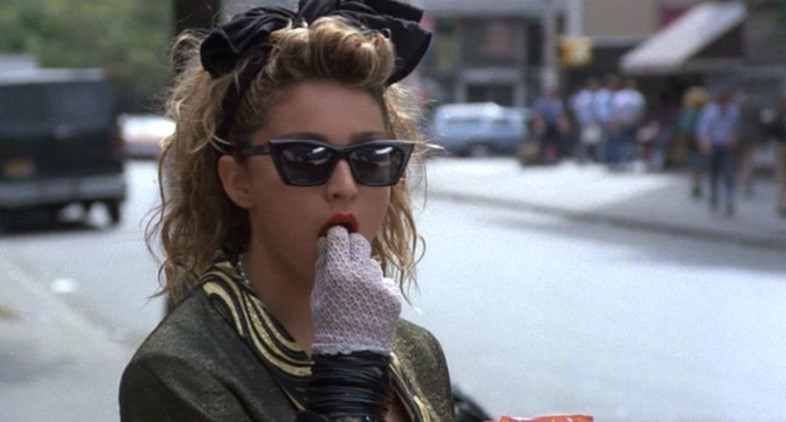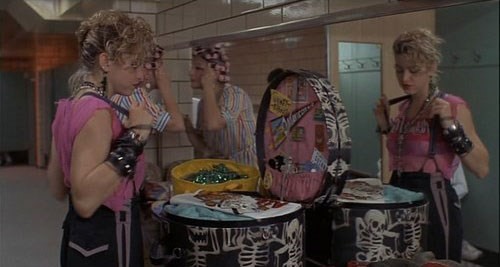Whether it's befriending a make-believe Madonna or second-hand shopping as a political act, we extract the lessons to be learned from the 1985 cult classic
On the runways of S/S17, the sartorially gluttonous codes of the 1980s were a pervasive influence. From Anthony Vaccarello’s debut at YSL (where he cast a nostalgic eye back to an era of gold lamé and gargantuan tasselled earrings), to the over-exaggerated shoulders at Céline and Balenciaga (hinting at the padded silhouettes of wall-street power dressing) and not forgetting the club kids at Marc Jacobs (despite his collection being heavily inspired by the undoubtedly 00s figure Lana Wachowski) where there was a palpable hint towards the gaudy ensembles of Culture Club’s Boy George. When considering such references, it’s an impossibility not to visually summon the spirit of an icon who arguably defined the excesses of 80s fashion: Madonna. Her first filmic role in Desperately Seeking Susan is one that encapsulated her signature style on screen – and subsequently, the delightfully over-the-top nuances of the decade.
The film chronicles a surreal journey of self-discovery experienced by the timid Roberta, played by the then up-and-coming Rosanna Arquette, who is searching for something beyond what her placid and unfulfilled life as a yuppie housewife is offering. Ultimately, the escapism she craves arrives in the form of Susan (Madonna) – a wayward drifter embodying the spirit of cool-girl nonchalance – who Roberta discovers advertising a meet up in Battery Park via the lonely hearts section of a New York City tabloid. Director Susan Seidelman cast the queen of pop to play a character who “floats through the funkiness in which she lives as if she were a princess” – an attitude which, without a doubt, we should all desperately seek.

1. Thrifting can be a political statement
Susan is never not clad in kitschy clothes – she seems permanently to be draped in the sheen of polyester and lycra, with an abundance of lace and the clinking and clacking of multiple trinkets following her wherever she goes. She has a particular penchant for gloves, which she refuses to take off – even to snack on Cheese Doodles – and presents as someone who has tripped and fallen into a clothes rail at a thrift store at all times. So naturally, when Susan arrives in New York, she immediately embarks on a second-hand shopping trip, falling in love with a pair of sequin boots in the window of her go-to store ‘Love Saves The Day’. Exchanging her jacket for the dazzling footwear, Roberta – who by this point has been following Susan's movements in complete awe – buys it for herself. Bringing the jacket home, Roberta’s yuppie husband is less than pleased: “You bought a used jacket? What are we – poor?” Thus, the theme of thrifting present throughout the film is suddenly rendered a political statement; representing an antithesis to the money-obsessed capitalist culture of the 1980s.

2. Surround your clothes with mythologies
The aforementioned jacket (tastefully crafted in a woven lamé and embellished with tiger print lapels, a golden pyramid applique and beaded third eye) forms an integral plot device within Desperately Seeking Susan. Not only does it act as a prop for a slapstick case of ‘mistaken identity’, but ultimately it became emblematic of the film’s history, fetching $252,000 at auction in 2014. Woven into the garment are the fabricated on-screen stories told by Susan and Roberta: supposedly, it once belonged to Jimi Hendrix, or Elvis Presley. Undoubtedly, clothing steeped in a history – mythical, filmic or otherwise – makes for a much more stimulating way to dress.

3. Pioneer the Insta-stalk
The first ever 'selfie' was taken by photographic pioneer Robert Cornelius circa 1839, but the practice exploded in the 1970s and 1980s when producing self-portraiture became commonplace. In one of the opening scenes of the film, Susan lounges on the floor of a motel surrounded by playing cards, taking a photo of herself using a polaroid camera (the image spat out from the machine ends up in the pocket of her gaudy pyramid jacket alongside a locker key, later to be discovered by Roberta). Like an analogue form of Instagram stalking, Roberta subsequently admires the polaroid in the bath and it ends up tacked to her mirror to serve as inspiration for when she is dressing up in appropriately Susan-esque garb.

4. Master the art of packing
During the hunt for Susan, Roberta finds her suitcase – a circular, handheld object covered in skeletons with contorted expressions – in a rented locker. Its contents reveal Susan’s impressive packing skills: an emerald green sequin dress; a multi-pack of Atlantic City cigarettes; two towels (one turquoise, one orange); multiple knives, forks and spoons; a corset; and a single earring from ancient Egypt.

5. Befriend an imaginary Madonna
During Roberta’s amnesiac episode, where she assumes the identity of Susan as a thrilling escape from a humdrum existence of domesticity, her sneering spouse is informed by the police that an affair is most likely the cause of her disappearance: “That’s ridiculous – she’s not having an affair, she’s much too uptight!” he wrongly assumes, simultaneously dismissing the fact that she would ever be seen smoking a joint. Throughout the film – which is, at times, unquestionably psychosomatic – it’s often debateable whether Susan is a real person or a symbol; a figment of Roberta’s imagination or a depiction of the person she imagines herself to be (extra-marital affairs and the smoking of illicit substances included).
